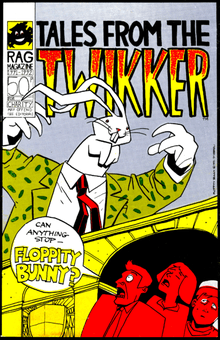Twikker



Twikker was the Rag Mag of Sheffield University Rag. The name is a corruption of The Wicker, a well-known street in Sheffield, South Yorkshire, England crossed at one end by the Wicker Arches (a railway viaduct).
('Twikker' is also the name of a rock climb in Derbyshire, first climbed (and therefore named) by a member of the Sheffield University Mountaineering Club.[1][2])
Sheffield Rag first produced a magazine in 1926, named "The Star", and by 1928, 85,000 copies were sold.[3][4] It was renamed Twikker in 1930,.[3] Rag itself was banned in 1942 until the war ended,[3] although the 1943 Twikker was written by torchlight in a bomb shelter![5] Publication of Twikker resumed in 1947. It is thought to be the longest-lasting example of the genre, although there are other claimants.
It is possible to follow the taste, or lack of it, of humour over the years through its content. Many jokes from the 1930s to 1950s were lacking in sexual innuendo but were casually racist and sexist by today's standards. Since the 1960s jokes were much 'nearer the knuckle'. In the 1980s racism and sexism were dropped or bowdlerised (e.g. Irish jokes became jokes about Mechanical Engineers). A particular example from 1939 is notable: "Advice to Hitler – Don't be vague, ask for Prague"[6] (a reference to the Munich agreement and the advertising tagline for Haig scotch). Present-day inclusion of Adolf Hitler in humour is widely considered beyond the pale, and was notably absent from post-war Twikkers.
The intention was generally to make the content as racy as possible, to boost sales, but at the risk of being banned: Twikker 1938 was withdrawn after leading churchmen complained of its 'obscenity'.[7] There are reports of the 1949 edition changing hands for £1 after its ban by the University for "offensive" material,[8][9] It upset the Lord Mayor of Sheffield, who traditionally bought the first copy, and was debated in the City Council, who labelled it "a disgrace to education"[8] and the 1950 edition was banned comprehensively – no copy exists today – and its editor was sent down from University.[10] The students published an alternative called 'Ragout' to raise funds that year.[11] Twikker 1959 provoked complaints from the public[12] and later editions courted controversy from Women's Liberation groups, ceasing its pin-ups in 1975 following a protest.[13] The Lord Mayor again condemned Twikker in 1987, and the Student Union (SUSU) itself imposed a ban which was debated by the largest ever SUSU meeting (approximately 1500 attended and voted 900:600 to overturn the ban).
Notable contributors
Hans Kornberg was the editor in 1947.[14]
The 1991 cover was created by D'Israeli.[15]
Forewords have been written by Michael Palin,[16] Andy Hamilton[17] and Miles Kington[18] in addition to the traditional Lord Mayor's foreword.
References and notes
- ↑ UK Climbing forums
- ↑ Rockfax database
- 1 2 3 Your University, The Magazine for Alumni and Friends of the University of Sheffield, 2006/2007, page 2, column 3
- ↑ The Cambridge University Library has copies back to 1930 Catalogue entry online. Accessed 1/11/06. and lists, in their handwritten catalogue, uncollected issues back to 1925.
- ↑ Twikker, 1943
- ↑ Twikker, 1939
- ↑ Twikker, 1990, p45; account by the 1938 editor.
- 1 2 Your University, The Magazine for Alumni and Friends of the University of Sheffield, 2005/2006 page 18-19]
- ↑ Annual Report to Information Services Committee, 8 November 2000; 8.3, page 8) (The University of Sheffield Library)
- ↑ Twikker, 1990, p50; account by the 1951 editor.
- ↑ Ragout (1950) - available with the collected Twikkers at copyright libraries such as Cambridge University.
- ↑ Twikker, 1990, p63; Reprinted letter from Sheffield Telegraph 29-10-1959 'Twikker? I burned mine'.
- ↑ Your University, The Magazine for Alumni and Friends of the University of Sheffield, 2006/2007, p. 3, column 2
- ↑ Twikker, 1947
- ↑ Twikker, 1991 and
- ↑ Twikker, 1985
- ↑ Twikker, 1988
- ↑ Twikker, 1990